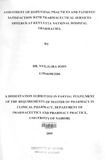| dc.description.abstract | Background: The label on the dispensed medicines has two main functions. One is to uniquely
identify the contents of the container. The other is to ensure that patients have clear and concise
information which will enable them to take or use their medicine in the most effective and
appropriate way. There are both legal and professional requirements which must be complied
with when labelling a dispensed medicine. It is the pharmacist's / pharmacy staff's responsibility
to ensure that these requirements are satisfied and that all labelling is accurate and
comprehensive. Prescribing patterns need to be evaluated periodically to increase therapeutic
efficacy, decrease adverse effects and provide feedback to prescribers. Availability of drugs at
the point of need has been a matter of great concern for health services all over the world,
especially for the less developed countries.
Patient satisfaction is a key indicator of the quality of health services. including nharmaceutical
services.
Goal of Study: To improve the quality of pharmaceutical services at Kenyatta National Hospital.
Objective: To determine the drug labelling practices, pattern of prescribing, drug availability
and the level of patient satisfaction with pharmaceutical services offered at KNH outpatient
pharmacies.
Study Design: Hospital pharmacy-based cross-sectional study.
Study Area: Four selected pharmacies at the Kenyatta National Hospital.
Sampling Technique: A systematic random sampling was used.
Study Population: 392 patients who received drugs from Kenyatta National Hospital outpatient
pharmacies between the months of April and October 2008.
Data Analysis: Data cleaning was done before analysis usmg SPSS software version 12
statistical package.
IV
Results: Generally, the product name appeared most (98%) followed by directions for use
(93%),"keep out of reach of children" (79%), quantity of medicine dispensed (62%), name and
address of the pharmacy / logo of the hospital (55%), other cautionary statements (53%), expiry
date(48%), patient name (23%), and prescription number (1%) and prescriber's name (0%).
The average number of drugs per prescription was 2.9 during the study period. The most
prescribed drugs were the cardiovascular system, anti-infectives and endocrine system drugs.
Only 45.4% of the respondents got all their prescribed medication in the pharmacy. Patient
knowledge was found to be satisfactory in 99.9% which indicated good pharmacy staff
instructions to the respondents.
The overall satisfaction level of the patients in this study was 78.6%. There was no association
observed between the level of satisfaction and the type of respondents, age, gender, marital
status,education, employment and number of visits.
Conclusion: Most labelling requirements were met since majority of them were above 50%,
there was satisfactory patients knowledge, the average number of drugs per prescription was 2.9
during the study period, however this was above the WHO recommendation of 1.6 drugs per
patient per encounter, only 45.4% of the respondents got all their prescribed medications in the
pharmacies, the most prescribed drugs were cardiovascular system, anti-infectives and endocrine
system drugs. Satisfaction level of patients was good.
Recommendation: Prescriber's number, name and address of the pharmacy should be in use for
easy tracing of the root cause of any problem which may arise during medication use by patients.
Prescribing of fewer drugs based on correct diagnosis should be implemented for the therapeutic
benefits of patients. Better availability of drugs should be based on essential medicines lists and
increasing of the hospital drug procurement budget. | en |
| dc.description.department | a
Department of Psychiatry, University of Nairobi, ; bDepartment of Mental Health, School of Medicine,
Moi University, Eldoret, Kenya | |

